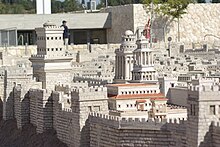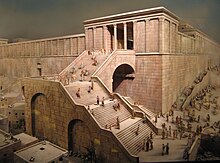David Citadel
The Citadel of David is a fortress in the old city of Jerusalem next to the Jaffa Gate . After a comprehensive archaeological survey and subsequent renovation of the building stock, the Museum of the City of Jerusalem opened in April 1989.
history
In the year 24 BC, Herod the Great had a fortress built with three massive defense towers ( Hippicus , Phasael and Mariamne ) on the western hill of Jerusalem on the foundations of an older complex to secure the west side of the city. The fortress served as the bastion of the western city gate and the adjoining Herod's palace in the newly built upper town. When the Romans razed the city after the Jewish War - during which the Herodian Temple was also destroyed - they left these three towers as a reminder of Jerusalem's former greatness. Two of the towers were destroyed in Byzantine times, the base of the third can still be seen today on Jaffa Gate. When Suleiman I the Magnificent built an old town wall in the 16th century, a citadel was added. This was also given a minaret in 1665 , which is now called the Tower of David .
Despite the name David Citadel , there is no reference to the biblical King David . The naming is based on an error: In Byzantine times it was wrongly concluded from the records of the Roman-Jewish historian Flavius Josephus that the Old Testament Jerusalem was on the western hill - on which the citadel stands today - and that the Phasael tower was related to the king David brought. In fact, the City of David was located south of the Temple Mount and Mount Ophel . The Muslims who conquered Jerusalem in 637 adopted the wrong assignment and gave the Phasael the name Mihrab of the prophet David . Western travelers, who visited Jerusalem in the 19th century in search of biblical traces, believed - again mistakenly - to recognize the said Tower of David in a minaret added to the citadel in the 17th century and thus transferred the earlier error of Phasael to an Ottoman mosque .
After the Jordanian Arab Legion captured the Old City of Jerusalem and the northern and eastern suburbs in the war for Israel's independence , the citadel became a legion's military camp. In the courtyard barracks and shelters had been built without any modern amenity such as sanitary facilities or electricity and remained so until the Six Day War .
Jerusalem City History Museum
Before a decision was made on how the citadel would be used in the future, the archaeologists Ruth Amiran , Avi Eitan , Hillel Geva , Rina Siwan and Giora Solar subjected the building to detailed research through excavations and structural investigations. Rich traces of the epochs from the time of the First Temple to the era of Sülayman the Magnificent came to light. The question was whether Jerusalem really needed another museum and whether the citadel was suitable as a museum. Ori Abramson, Talli Ornan and Jeschajahu Weinberg had drafted an idea for the museum by the end of 1984 and submitted it to the city, which approved it the following year. The museum opened its doors in April 1989.
According to the plan, the museum was created without its own collection, but using exhibits from the many other museums in the city, media, models, reconstructions and replicas in the exhibitions to give the viewer an introduction to Jerusalem as a theme. The city's history is presented in chronological order as a historical continuum, with the exhibition divided into epoch rooms providing information on the most important events of the epochs. According to the concept, the museum does not burst with exhibits that can provide great guidance on the knowledge of the city, but which are often only understood by the initiated. The museum is aimed at visitors without any special prior knowledge and uses media to introduce visitors to the city's history, which do not keep visitors at a distance, but want to involve them. Kitsch is avoided and historical authenticity is preserved.
However, it seemed problematic to use the citadel, which is a sight in itself, as a museum of the city's history, which could distract the viewer from the actual building or, conversely, from the exhibition. Its use as a museum does not affect the substance of the citadel building that has been made accessible and secured through excavations and renovation, so only existing rooms are used, no new buildings are added. The 634 square meters of exhibition space, which is available without new buildings, are divided into rooms for over 3000 years of city history, divided into eight epochs, which then make up an average of 75 square meters.
Exhibits, display boards and text panels such as projection surfaces are therefore often drawn into the center of the rooms so as not to cover the walls of the citadel as an independent object. The building fabric is part of the exhibition, but the exhibits and exhibition facilities are not integrated into it, but retain their approach, which creates a constant dialogue. The viewer is not overwhelmed by the abundance of objects, but rather opens up the exhibition at their own pace.
The show works out the importance of Jerusalem for the three monotheistic religions ( Judaism , Christianity and Islam ) and places a focus on Jerusalem's unique importance in the life of Jews through the ages, with the greatest care balancing contrasting aspects. The exhibition encourages visitors to visit and explore sites of historical events, cultural significance or urban impact outside the museum walls. The museum offers various thematic routes through the building, outdoor facilities and exhibition, and despite structural restrictions, it is also a barrier-free tour.
The museum has an educational department that prepares and offers seminars and courses, an information center on the history of Jerusalem and event rooms that can be used for various occasions. In addition, a room is used for changing exhibitions. The museum education goes to different needs of the heterogeneous visitor shaft to which are children or teenagers on school trips, foreign or foreign youths on city travel , soldiers in the training program, locals, tourists , new residents , Jerusalem experts such as academics, city guide or local historian and -kundelehrer . The department develops study programs on subjects such as architecture, society, culture, politics, religion, urbanism or the economy of the city.
Individual evidence
- ↑ a b c Ori Abramson, "The Museum in the Tower of David", Rachel Grünberger (transl.), In: Ariel: Eine Zeitschrift zur Kunst und Bildung in Israel , No. 83 (1992), pp. 50–61, here p. 61. ISSN 0334-2719.
- ↑ a b c d e f Ori Abramson, "The Museum in the Tower of David", Rachel Grünberger (transl.), In: Ariel: Eine Zeitschrift zur Kunst und Bildung in Israel , No. 83 (1992), pp. 50-61, here p. 50. ISSN 0334-2719.
- ↑ Ori Abramson, “The Museum in the Tower of David”, Rachel Grünberger (transl.), In: Ariel: A magazine for art and education in Israel , No. 83 (1992), pp. 50–61, here p. 51. ISSN 0334-2719.
- ↑ Ori Abramson, "The Museum in the Tower of David", Rachel Grünberger (transl.), In: Ariel: A magazine for art and education in Israel , No. 83 (1992), pp. 50-61, here p. 51seq. ISSN 0334-2719.
- ↑ a b c d e Ori Abramson, "The Museum in the Tower of David", Rachel Grünberger (transl.), In: Ariel: A magazine for art and education in Israel , No. 83 (1992), pp. 50-61, here P. 52. ISSN 0334-2719.
- ↑ a b Ori Abramson, “The Museum in the Tower of David”, Rachel Grünberger (transl.), In: Ariel: Eine Zeitschrift zur Kunst und Bildung in Israel , No. 83 (1992), pp. 50-61, here p. 58 ISSN 0334-2719.
- ↑ a b c d Ori Abramson, "The Museum in the Tower of David", Rachel Grünberger (transl.), In: Ariel: A magazine for art and education in Israel , No. 83 (1992), pp. 50-61, here p 59. ISSN 0334-2719.
- ↑ Ori Abramson, "The Museum in the Tower of David", Rachel Grünberger (transl.), In: Ariel: A magazine for art and education in Israel , No. 83 (1992), pp. 50-61, here p. 59seq. ISSN 0334-2719.
- ↑ a b c Ori Abramson, "The Museum in the Tower of David", Rachel Grünberger (transl.), In: Ariel: Eine Zeitschrift zur Kunst und Bildung in Israel , No. 83 (1992), pp. 50–61, here p. 60. ISSN 0334-2719.
Web links
- Website of the museum in the citadel (German / English)
- A virtual tour of the citadel
- Jerusalem Photo Portal - Tower of David
Coordinates: 31 ° 46 ′ 34.1 ″ N , 35 ° 13 ′ 40.4 ″ E





